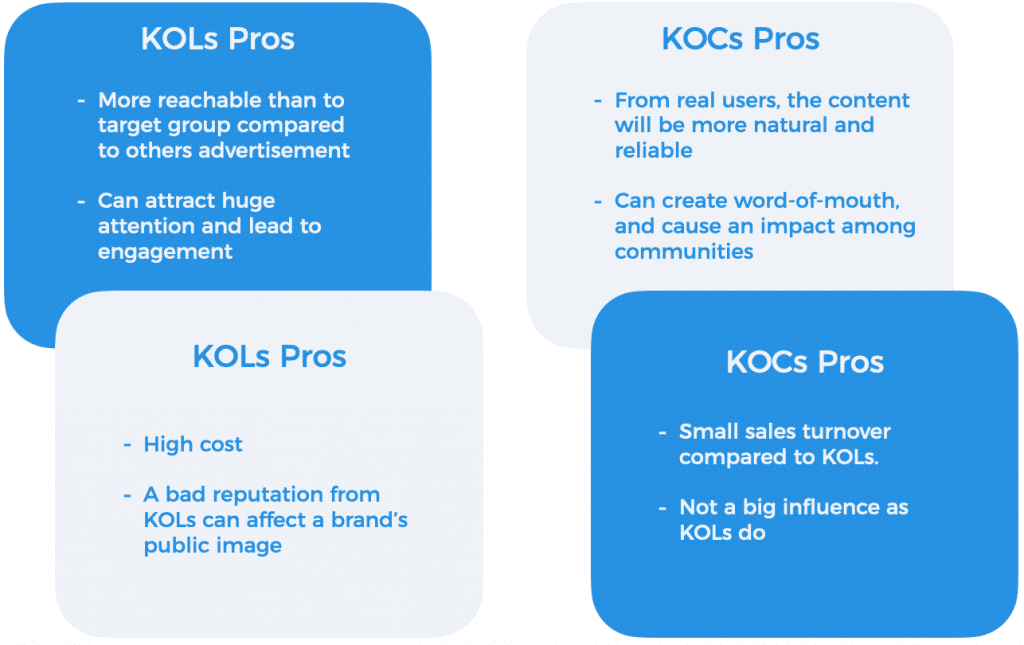
Navigating Online Meeting Fatigue: Strategies for Zoom and Beyond
Online meetings can be both a blessing and a curse. Here’s how we think you should handle them to make them more the former than the latter.

For brands, partnerships with people who can influence consumer behaviors can be a great way to get their messages in front of new audiences. In today’s social media and influencer marketing-driven climate, KOLs and KOCs are vital components of brands’ marketing strategy either offline marketing and digital marketing.
Even those KOLs and KOCS are sharing the same value as an influencer in marketing strategy, but they still have some differences and similarities among themselves. This article will make you understand more about KOLs and KOCs.
A Key Opinion Leader, or KOL, is a media user who has a huge fan base and a large social media following, and whose followers recognize their competence or experience in a specific sector. KOLs are individuals who have the ability to greatly influence the purchasing decisions of others due to their extensive knowledge or authority in a given area. Companies are keen to pay KOLs to advertise their products because of their significant influence. KOLs in the food sector, for example, could be someone with a huge social media following who often updates their main feed with updates on their own cooking, reviewing food, or eating content.

An example of KOL in the food industry. Tasty is a huge KOL who specialised in the food industry with 96 Million followers on their Facebook Fanpage. Providing contents about recipes, cooking tips can influence greatly on followers that share mutual interest.
The KOLs and the KOCs are not equivalent in any way. The value of Key Opinion Customer, or KOC, is derived from the opinions they express based on their personal experiences with a variety of products and services. The fact that they do not adhere to the status quo makes it easier for the audience to relate to them. It is noteworthy to observe that KOCs often have a small number of followers but great review skills. Even if they have a small followers (maybe just a thousand), the fact that they share and review their own personal experience with the product drives a substantial number of individuals to trust them. And as they continue to do this, the number of people who follow them will increase over time. Do not underestimate the effect of KOLs, as their followers are readily affected by their beliefs, which could influence whether or not their followers purchase a product or service.
When firms want to promote their products or services, they routinely contact KOLs and offer them money or free products. Conversely, KOCs usually contact brands in order to test or review products they are considering purchasing.
This follower is used to categorise KOLs into one of three groups: nano-influencers (1,000 to 10,000 followers), micro-influencers (10,000 to 50,000 followers), and mega (one million or more followers).
The audience size is not relevant to KOCs. Brand may consider a KOCs strategy choosing more “quantity” which achieves word-of-mouth communication and brand recommendation. In marketing it is also called “seeding”. Brands – based on budget of course – can contact many KOC asking them to publish their product reviews. Often the brand can plan a calendar and “seed” the reviews on multi-platforms.
KOCs are also considered to be end-users; however, they are separated from other end-users by the fact that they keep personal blogs or video blogs in which they discuss the products they use. KOLs are compensated for their involvement with brands, making their authenticity less persuasive than that of KOC.

If you have just launched your business and have a limited budget for social media marketing, it may make sense to use KOCs to have an impression on your target audience at a low price.

Online meetings can be both a blessing and a curse. Here’s how we think you should handle them to make them more the former than the latter.

Learn how to leverage brand awareness for increased sales and business growth. Unlock the power of branding to maximize revenue potential.

Live Commerce หรือก็คือ ‘ไลฟ์สดขายของ’ ที่เติบโตสุดๆ ในโลกยุคดิจิตอล แต่อะไรกันแน่ที่ทำให้คนชอบดู ชอบช้อปในไลฟ์?
1015/29 Sukhumvit 71 Road,
Watthana, Bangkok 10110
©2024, MOST 2414 Co., Ltd. • VAT No. 0105558155913 • Terms & Conditions • Privacy Policy • PDPA • Sitemap
| Cookie | Duration | Description |
|---|---|---|
| cookielawinfo-checbox-analytics | 11 months | This cookie is set by GDPR Cookie Consent plugin. The cookie is used to store the user consent for the cookies in the category "Analytics". |
| cookielawinfo-checbox-functional | 11 months | The cookie is set by GDPR cookie consent to record the user consent for the cookies in the category "Functional". |
| cookielawinfo-checbox-others | 11 months | This cookie is set by GDPR Cookie Consent plugin. The cookie is used to store the user consent for the cookies in the category "Other. |
| cookielawinfo-checkbox-necessary | 11 months | This cookie is set by GDPR Cookie Consent plugin. The cookies is used to store the user consent for the cookies in the category "Necessary". |
| cookielawinfo-checkbox-performance | 11 months | This cookie is set by GDPR Cookie Consent plugin. The cookie is used to store the user consent for the cookies in the category "Performance". |
| viewed_cookie_policy | 11 months | The cookie is set by the GDPR Cookie Consent plugin and is used to store whether or not user has consented to the use of cookies. It does not store any personal data. |